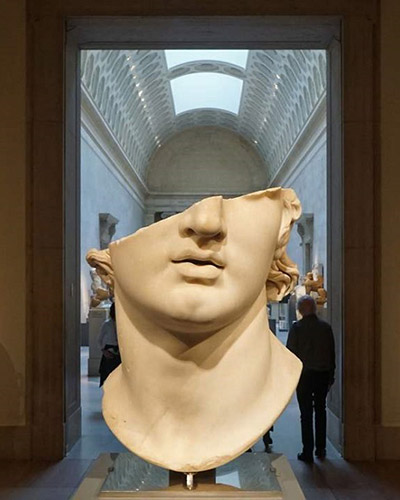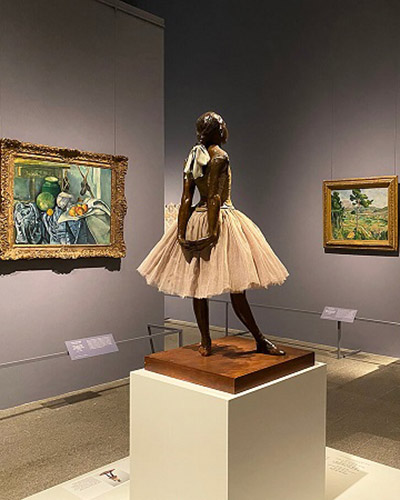Louvre Museum
This article is about the Louvre Museum. For the building, see Louvre Palace. For other uses, see Louvre
(disambiguation).
The Louvre (English: /ˈluːv(rə)/ LOOV(-rə)[4]), or the Louvre Museum (French: Musée du Louvre [myze dy luvʁ]
(About this soundlisten)), is the world's largest art museum and a historic monument in Paris, France, and
is best known for being the home of the Mona Lisa. A central landmark of the city, it is located on the
Right Bank of the Seine in the city's 1st arrondissement (district or ward). Approximately 38,000 objects
from prehistory to the 21st century are exhibited over an area of 72,735 square meters (782,910 square
feet). Due to the COVID-19 pandemic, the museum was closed for 150 days in 2020, and attendance plunged by
72 percent to 2.7 million. Nonetheless, the Louvre still topped the list of most-visited art museums in the
world in 2020.
.jpg)
.jpg)
The museum opened on 10 August 1793 with an exhibition of 537 paintings, the majority of the works being
royal and confiscated church property. Because of structural problems with the building, the museum was
closed in 1796 until 1801. The collection was increased under Napoleon and the museum was renamed Musée
Napoléon, but after Napoleon's abdication, many works seized by his armies were returned to their original
owners. The collection was further increased during the reigns of Louis XVIII and Charles X, and during the
Second French Empire the museum gained 20,000 pieces. Holdings have grown steadily through donations and
bequests since the Third Republic. The collection is divided among eight curatorial departments: Egyptian
Antiquities; Near Eastern Antiquities; Greek, Etruscan, and Roman Antiquities; Islamic Art; Sculpture;
Decorative Arts; Paintings; Prints and Drawings.
.jpg)
The Smithsonian gives an approximate number for artifacts and specimens of 146 million.[42] More
specifically, the collections include 30 million insects, 4.5 million plants preserved in the
Museum's herbarium, and 7 million fish stored in liquid-filled jars.[43] The National Collection of
Amphibians and Reptiles has more than tripled from 190,000 specimen records 1970 to over 580,000
specimen records in 2020.[44][45] Of the 2 million cultural artifacts, 400,000 are photographs
housed in the National Anthropological Archives.[43] Through off-site active loan and exchange
programs, the museum's collections can be accessed.[46] As a result, 3.5 million specimens are out
on loan every year.[43] The rest of the collections not on display are stored in the non-public
research areas of the museum and at the Museum Support Center, located in Suitland, MD.[47] Other
facilities include a marine science center in Ft. Pierce, Florida and field stations in Belize,
Alaska, and Kenya.
.jpg)
The Musée du Louvre contains more than 380,000 objects and displays 35,000 works of art in eight curatorial
departments with more than 60,600 square metres (652,000 sq ft) dedicated to the permanent collection.[2]
The Louvre exhibits sculptures, objets d'art, paintings, drawings, and archaeological finds.[9] It is the
world's most visited museum, averaging 15,000 visitors per day, 65 percent of whom are foreign tourists.
The Hall of Dinosaurs has fossilized skeletons and cast models, including Tyrannosaurus rex cast facing
a Triceratops cast. The Triceratops exhibit shows the first accurate dinosaur skeleton in virtual
motion, achieved through the use of scanning and digital technology."[58][59] The collection consists of
46 "complete and important specimens" of dinosaurs.
.jpg)
Before the Grand Louvre overhaul of the late 1980s and 1990s, the Louvre had several street-level entrances,
most of which are now permanently closed. Since 1993, the museum's main entrance has been the underground
space under the Louvre Pyramid, or Hall Napoléon, which can be accessed from the Pyramid itself, from the
underground Carrousel du Louvre, or (for authorized visitors) from the passage Richelieu connecting to the
nearby rue de Rivoli. A secondary entrance at the Porte des Lions, near the western end of the Denon Wing,
was created in 1999 but is not permanently open.
The museum's entrance conditions have varied over time; artist visitors long had privileged access, a
feature that has disappeared over time. At the time of initial opening in 1793, the French Republican
calendar had imposed ten-days "weeks" (French: décades), the first six days of which were reserved for
visits by artists and foreigners and the last three for visits by the general public.[13]:37 In 1824, a new
regulation allowed public access only on Sundays and holidays; the other days the museum was open only to
artists and foreigners, except for closure on Mondays.[13]:39 That changed in 1855 when the museum became
open to the public all days except Mondays.[13]:40 It was free until 1922, when an entrance fee was
introduced except on Sundays.[13]:42 Since its post-World War II reopening in 1946,[13]:43 the Louvre has
been closed on Tuesdays, and habitually open to the public the rest of the week except for some holidays.
The use of cameras and video recorders is permitted inside, but flash photography is forbidden.
.jpg)
.jpg)
.jpg)
.jpg)
.jpg)







